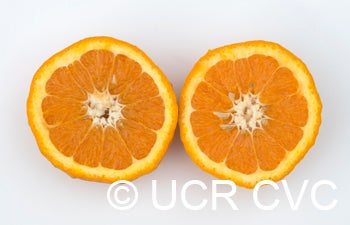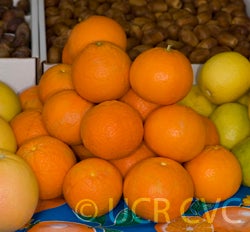Citrus × tangelo
CRC 3874
PI 539711
VI 19
Source
Received as budwood from USDCS, Indio, CA, via CCPP, 1958.
Parentage/origins
Orlando is a sibling of Minneola tangelo, having Duncan grapefruit and Dancy mandarin as its parents.
Rootstocks of accession
Carrizo citrange, C-35 citrange, Cleopatra mandarin, Swingle citrumelo
Season of ripeness at Riverside
November to January
Notes and observations
The tree is moderately vigorous and slightly more cold resistant than Minneola. The leaves of Orlando tend to be cupped, and the fruit is almost round or slightly flattened. The rind is orange, thin, slightly textured, and not easily peeled. The flesh is orange, juicy, and sweet. The season of maturity is early. As with Minneola, Orlando’s blossoms are self-incompatible, and must be pollinated by a suitable pollinator to ensure satisfactory fruit set. As with Minneola, cross-pollinated fruits are seedy.
L.K Jackson and S.H. Futch: "Originally this variety was known as "Lake tangelo", but changed to "Orlando" many years ago. The size and shape are tangerine like with an average diameter of 2 3/4 to 3 inches, with the color and texture more closely the color of an orange. Seed number will vary depending on cross-pollination from a low of zero seeds in solid blocks to as many of 35 seeds per fruit in blocks of high pollination. The rind adheres firmly to the pulp and is not easily peeled by hand. Since this variety produces poorly in solid set blocks, it is recommended that cross-pollination with Temple, Robinson, or Sunburst be used to enhance yields. Commericial harvest season is from November to January. The tree will grow to a large size and the foliage is easily recognized by the characteristic cup-shaped leaves. This variety is recognized as being one of the more cold tolerant varieties."
Description from The Citrus Industry Vol. 1 (1967)
"Fruit medium-large, broadly oblate to subglobose; without neck; seedy. Rind orange-colored; thin, slightly pebbled, and fairly tightly adherent (not free-peeling). Segments numerous (12-14); axis small and hollow. Flesh orange-colored; tender, very juicy; flavor mildly sweet. Season of maturity early.
Tree somewhat similar to Minneola but with distinctively cupped leaves; somewhat more cold resistant; less vigorous; cross pollination recommended for regular and good production. Dancy, Clementine, and Kinnow mandarins and Temple tangor are said to be good pollinators. Minneola tangelo is cross-incompatible.
Orlando is of the same parentage as Minneola and Seminole—a hybrid of Duncan grapefruit and Dancy tangerine. Originally it was named Lake, but it was later renamed to avoid confusion. Its earliness of maturity, good shipping quality, and pleasant flavor made it the outstanding popular tangelo in Florida, where the annual production in 1965 exceeded a million boxes. In the low elevation regions of Arizona and California, there is increasing interest in its culture. Total plantings in 1964 consisted of 610 acres.
Availability
Commercially available in California through the Citrus Clonal Protection Program. Click here to order budwood.
USDA Germplasm Resources Information Network page for Orlando tangelo
Bibliography
"Facts about specialty citrus characteristics", L.K. Jackson and S. H. Futch, Citrus Industry, April 1994, pgs. 57 & 66.



